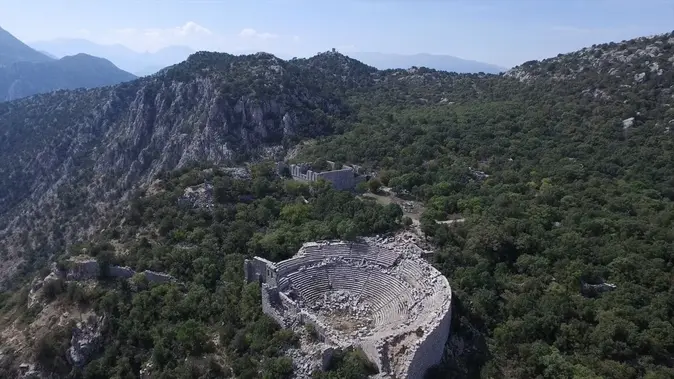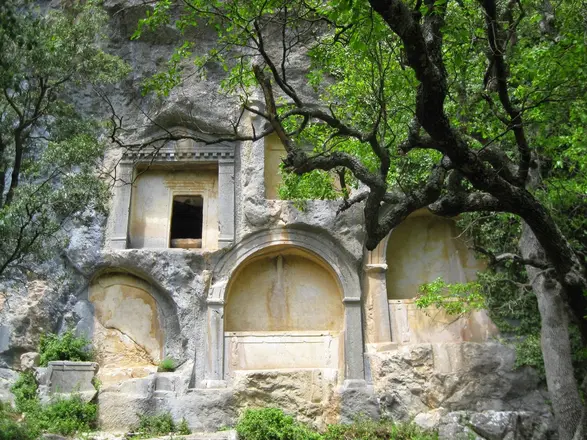Güllük Mountain (Termessos) National Park
Description
Geological Structure
The steep cliffs of Güllük Mountain and the Mecine Canyon, whose walls rise up to 600 m, are the most important geological resource values.
FAUNA
Mammals: Wild boar, fox, jackal, caracal, caracal, wild cat, badger, rabbit, marten, squirrel, hedgehog, roe deer, mountain goat, tree eel, bat, lynx are the mammal species found in the National Park.
Birds 113 of the 456 bird species found in Turkey can be seen in this National Park. Roe deer, Shah eagle, quail, woodcock, partridge, partridge, partridge and dove are among the main species.
Reptiles It has been determined that 20 reptile species live within the borders of the National Park. Turtle (Land Turtle), Spotted Turtle, Blind Lizard, Spiny Lizard, Half Fingered Lizard, Slender Lizard, Spotted Lizard, Coin Snake and Banded Viper are the main ones.
FLORA
In the national park, which has a rich biological diversity with an elevation difference of 250-1665m and a different aspect, 680 plant species such as mastic tree, wild olive, sandalwood, carob, laurel, rosary, etc. have been identified within the forest and maquis cover exhibiting the plant communities of the Mediterranean climate type, and 80 (11.76%) of them have been identified as endemic to Turkey. Mountain Ecosystem; 250-1665 m. It consists of red pine forest, Mediterranean maquis vegetation and rocky areas.
CULTURAL AND ARCHAEOLOGICAL VALUES
Termessos, which is one of the best preserved ancient cities in terms of archaeological sites in Anatolia and gives its name to the national park, is located at an altitude of 1050 m above sea level on the slopes of Güllük Mountain of the Taurus Mountains, rising after the travertine steps that form wide plains in the north of Antalya.
The city of Termessos was founded by the Solims, one of the indigenous peoples of Anatolia, known for their warrior character. The first information about Termessos and the Solims is derived from the history of Herodotus and Homer's Iliad Epic, based on the legend of Bellerofontes. The emergence of Termessos on the stage of history begins in 334 BC, when it was the only city that Alexander could not capture while passing through the region.
The oldest of the existing structures in Termessos are the tombs from the Hellenistic period. Other remains belong to the Roman period. It is estimated that the people of Termessos abandoned their city when the Roman influence in Asia Minor decreased. It developed in 3 sections as the lower city, city center and cemetery and lived its heyday during the Roman period. The city walls, towers, king's road, Hadrian's Gate, Gymnasium, Agora, Theater, Odeon, richly decorated tombs, cisterns and drainage system that provide the water of the city are the remains of the most magnificent structures of Termessos.
CURRENT LAND USE
The Administration and Visitor Information Center within the National Park is equipped with all kinds of equipment to provide visitors with information about the park. As a "Nature School", it is a field where nature lessons are carried out practically in cooperation with the General Directorate of National Parks and Game and Wildlife, universities and TÜBİTAK.
In the Day Use Area; there are 1 Toilet-Baby Care Room and Masjid, children's playground, fountains, picnic units and barbecue units, parking areas.
GÜLLÜK MOUNTAIN (TERMESSOS) NATIONAL PARK SIGHTS
- Termessos Ancient City
- Forest Ecosystem,
- Administration and Visitor Information Center,
- Daily Use Area.
ACTIVITIES THAT CAN BE DONE IN GÜLLÜK MOUNTAIN (TERMESSOS) NATIONAL PARK
- Ancient City Excursion,
- Observation of Rich Vegetation and Geological Structure,
- Administration and Visitor Promotion Center Visit
- Nature Walk
- Picnic
- Photography
- Cycling Sport
- Mountaineering is possible.
TRANSPORT
The National Park is 34 km from Antalya and can be reached by Antalya-Korkuteli highway.
Short Description
The steep cliffs of Güllük Mountain and the Mecine Canyon, whose walls rise up to 600 m, are the most important geological resource values.







